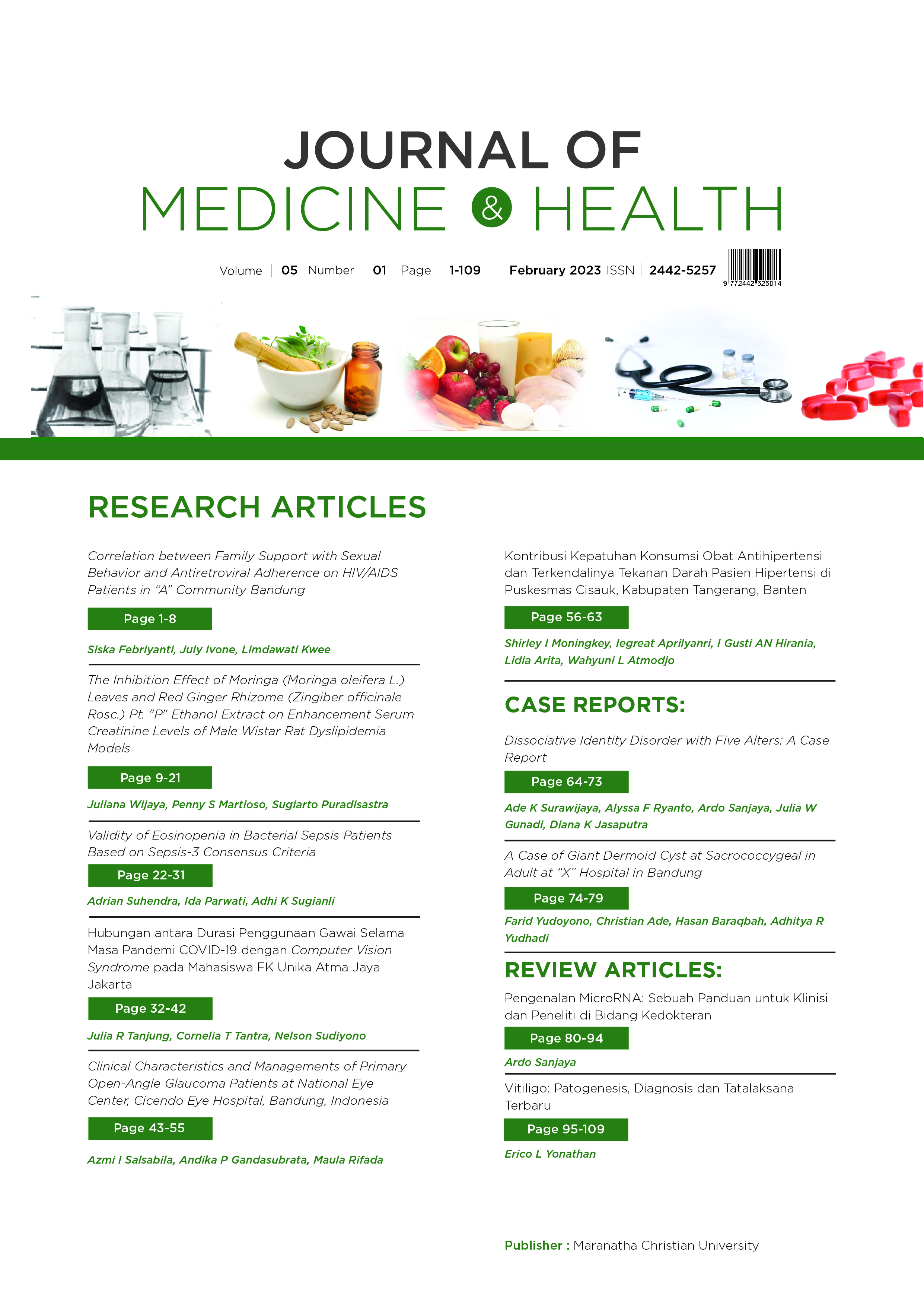Vitiligo: Patogenesis, Diagnosis dan Tatalaksana Terbaru
DOI:
https://doi.org/10.28932/jmh.v5i1.3954Keywords:
autoimun, patogenesis, diagnosis, tatalaksana, vitiligoAbstract
Vitiligo merupakan kelainan pigmentasi kronis dengan prevalensi sekitar 1% populasi dunia. Vitiligo ditandai dengan lesi makula depigmentasi, tidak berskuama, berwarna putih seperti kapur, dan biasanya asimtomatik. Hipotesis terjadinya vitiligo pertama kali dilaporkan sekitar tahun 1950 berupa hipotesis genetik. Artikel ini bertujuan membahas mengenai patogenesis, diagnosis dan tatalaksana vitiligo terbaru. Artikel reviu ini ditulis berdasarkan sumber pustaka berupa buku teks kedokteran dan jurnal-jurnal yang dipublikasikan dalam 10 tahun terakhir. Penelitian terbaru mengenai patogenesis vitiligo banyak diteliti, di antaranya adalah genetik, stres oksidatif, proses autoimun, gangguan adhesi melanosit, neurohumoral, autositotoksisitas, defisiensi vitamin D, hiperhomosisteinemia, dan teori konvergensi. Diagnosis vitiligo ditegakkan berdasarkan pemeriksaan fisik, serta pemeriksaan penunjang sesuai indikasi. Terapi vitiligo konvensional meliputi terapi farmakologi, fototerapi, dan pembedahan. Terapi vitiligo konvensional tidak berfokus pada patogenesis terjadinya vitiligo. Simpulan, Terapi vitiligo terbaru memiliki tiga prinsip, yaitu mengurangi stres pada melanosit, mengatur autoimunitas, dan stimulasi regenerasi melanosit sedang dilakukan. Terapi vitiligo terbaru diharapkan dapat meningkatkan efektivitas terapi. Penelitian efektifitas terapi terbaru pada vitiligo perlu dilakukan lebih lanjut.Downloads
References
Rahmayanti ND, Rahmadewi. Studi retrospektif : profil pasien baru vitiligo. Berk Ilmu Kesehat Kulit dan Kelamin. 2016;28(2):52–8.
Abreu ACG, Duarte GG, Miranda JYP, Ramos DG, Ramos CG, Ramos MG. immunological parameters associated with vitiligo treatments: A literature review based on clinical studies. Autoimmune Dis. 2015;2015:1-5.
Bergqvist C, Ezzedine K. Vitiligo: A review. Dermatology. 2020;236(6):571–92.
Rahman R, Hasija Y. Exploring vitiligo susceptibility and management: a brief review. Biomed Dermatology. 2018;2(20):1–13.
Lee H, Lee MH, Lee DY, Kang HY, Kim KH, Choi GS, et al. Prevalence of vitiligo and associated comorbidities in Korea. Yonsei Med J. 2015;56(3):719–25.
Gamal A, El-Barbary R, Moftah N. Updates in surgical treatment of vitiligo. J Recent Adv Med. 2021;2(1):118–27.
Dillon AB, Sideris A, Hadi A, Elbuluk N. Advances in vitiligo: An update on medical and surgical treatments. J Clin Aesthet Dermatol. 2017;10(1):15–28.
Anurogo D, Ikrar T. Vitiligo. CDK-220. 2014;41(9):666–75.
Arora A, Kumaran M. Pathogenesis of vitiligo: An update. Pigment Int. 2017;4(2):65–77.
Ashwini P, Sushmita D, Veeranna S. Vitiligo with special emphasis on vitiligo surgery. Arch Med Heal Sci. 2020;8(1):140–6.
Ezzedine K, Silverberg N. A practical approach to the diagnosis and treatment of vitiligo in children. Pediatrics. 2016;138(1):1–12.
Choi D, Isedeh P, Hamzavi I. Vitiligo: a review of the pathogenesis. J Egypt Women’s Dermatologic Soc. 2014;11(3):145–58.
Salim YF, Lestari S. Terapi bedah pada vitiligo. Maj Kedokt Andalas. 2018;41(2):88–93.
Rahim Zar A, Malik A, Mahmood A, Ahmad Naseer Q, Yumei L. Pathogenesis and the emerging therapy of vitiligo. Arch Clin Biomed Res. 2019;3(6):361–73.
Rashighi M, Harris JE. Vitiligo pathogenesis and emerging treatments. Dermatol Clin. 2017;35(2):257–65.
Mohammed GF. Highlights in pathogenesis of vitiligo. World J Clin Cases. 2015;3(3):221.
Kumar R, Tyagi S. A review on natural treatment’s of vitiligo. Asian J Pharm Res. 2020;10(4):263–7.
Birlea SA, Spritz RA, Norris DA. Vitiligo. In: Goldsmith LA, Katz SI, Gilchrest BA, Paller AS, Leffell DJ, Wolff K, editors. Fitzpatrick’s dermatology in general medicine. 8th Editio. The McGraw-Hill Companies; 2012. p. 792–803.
Spritz R, Andersen G. Genetics of vitiligo. Dermatol Clin. 2017;35(2):245–55.
Colucci R, Dragoni F, Moretti S. Oxidative stress and immune system in vitiligo and thyroid diseases. Oxid Med Cell Longev. 2015;2015:1–7.
Qiu L, Song Z, Setaluri V. Oxidative stress and vitiligo: The Nrf2-ARE signaling connection. J Invest Dermatol. 2014;134(8):2074–6.
Wang Y, Li S, Li C. Perspectives of new advances in the pathogenesis of vitiligo: From oxidative stress to autoimmunity. Med Sci Monit. 2019;25:1017–23.
Custurone P, Di Bartolomeo L, Irrera N, Borgia F, Altavilla D, Bitto A, et al. Role of cytokines in vitiligo: Pathogenesis and possible targets for old and new treatments. Int J Mol Sci. 2021;22(11429):1–14.
Mansuri MS. Could ER stress be a major link between oxidative stress and autoimmunity in vitiligo? J Pigment Disord. 2014;01(03):1-14.
Bishnoi A, Parsad D. Clinical and molecular aspects of vitiligo treatments. Int J Mol Sci. 2018;19(1509):1–15.
Riding RL, Harris JE. The role of memory CD8 + t cells in vitiligo . J Immunol. 2019;203(1):11–19.
Said-Fernandez S, Sanchez-Dominguez C, Salinas-Santander M, Martinez-Rodriguez H, Kubelis-Lopez D, Zapata-Salazar N, et al. Novel immunological and genetic factors associated with vitiligo: A review. Exp Ther Med. 2021;21(4):1–13.
Tarlé RG, do Nascimento LM, Mira MT, de Castro CCS. Vitiligo - Part 1. An Bras Dermatol. 2014;89(3):461–70.
Frisoli ML, Harris JE. Vitiligo: Mechanistic insights lead to novel treatments. J Allergy Clin Immunol. 2017;140(3):654–62.
Ghosh D, Ghosh S. A current review on the pathogenesis and treatments of Vitiligo. Int J Curr Res Rev. 2020;12(21):19–24.
Cui T, Zhang W, Li S, Chen X, Chang Y, Yi X, et al. Oxidative stress–induced HMGB1 release from melanocytes: A paracrine mechanism underlying the cutaneous inflammation in vitiligo. J Invest Dermatol. 2019;139(10):2174–84.
Karagun E, Ergin C, Baysak S, Erden G, Aktas H, Ekiz Ö. The role of serum vitamin D levels in vitiligo. Postep Dermatologi Alergol. 2016;33(4):300–2.
Amer A, Galal Khater E, Marei A, A. Firjani B. Evaluation of serum level of 25-hydroxy vitamin d in vitiligo patients. Zagazig Univ Med J. 2019;25(6):935–40.
Nahidi Y, Meibodi NT, Esmaili H. Serum homocysteine level in vitiligo patients. Iran J Dermatology. 2014;17(3):81–4.
Faria AR, Mira MT, Tarlé RG, Silva de Castro CC, Dellatorre G. Vitiligo - Part 2 - Classification, histopathology and treatment. An Bras Dermatol. 2014;89(5):784–90.
Yadav AK. Histopathology and molecular pathology of vitiligo [database on the Internet]: IntechOpen [update 2019 Oct 23; Cited 2021 Sept 3]. Available from: https://www.intechopen.com/chapters/69700
Veasey JV, Fraletti Miguel BA, Bedrikow RB. Wood’s lamp in dermatology: applications in the daily practice. Surg Cosmet Dermatology. 2017;9(4):324–6.
Al-Refu K. Dermoscopy is a new diagnostic tool in diagnosis of common hypopigmented macular disease: A descriptive study. Dermatology Reports. 2019;11(1):1–7.
Lei TC, Xu AE, Gao TW, He L, Gu H, Li M, et al. Consensus on the diagnosis and treatment of vitiligo in china (2021 revision). Int J Dermatology Venereol. 2021;4(1):10–5.
Kawakami T, Hashimoto T. Disease severity indexes and treatment evaluation criteria in vitiligo. Dermatol Res Pract. 2011;2011:4–7.
Refat MA, Harris JE. Emerging treatments for vitiligo: Gaining insight from pathogenesis. J Egypt Women’s Dermatologic Soc. 2017;14(1):1–8.
Sarkar SK, Sen KG, Mostofa MK. Review article vitiligo management- an update. Faridpur Med Coll J. 2017;12(1):34–9.
Suryawanshi M. Introduction to vitiligo and its treatment: A eeview. Int J Pharm Res Med Plants. 2018;1(4):72–5.
Gianfaldoni S, Wollina U, Tirant M, Tchernev G, Lotti J, Satolli F, et al. Herbal compounds for the treatment of vitiligo: A review. Open Access Maced J Med Sci. 2018;6(1):203–7.
Luo Y, Qian W, Dai T, Ru Y, Sun X, Kuai L, et al. A new therapy for vitiligo using fire needles: A systematic review of evidence from 3618 subjects. Evidence-based complement. Altern Med. 2020;2020:1–19.
Djerrou Z. Successful treatment of facial vitiligo with honey bee, allium cepa and avena sativa combined to sun light exposure: A case clinical trial. Int J Pharm Clin Res. 2015;7(1):9–14.
Stiegler J, Brickley S. Vitiligo: A comprehensive overview. J Dermatol Nurses Assoc. 2021;13(1):18–27.
Verma D, Hussain K, Namiq KS, Firoz A, Bouchama M, Raza M, et al. Vitiligo: The association with metabolic syndrome and the role of simvastatin as an immunomodulator. Cureus. 2021;13(3):1–10.
Kubelis-Lopez D, Zapata-Salazar N, Said-Fernandez S, Sanchez-Dominguez C, Salinas-Santander M, Martinez-Rodriguez H, et al. Updates and new medical treatments for vitiligo (Review). Exp Ther Med. 2021;22(2):1–11.
Passeron T. Medical and maintenance treatments for vitiligo. Dermatol Clin. 2017;35(2):163–70.
Downloads
Published
How to Cite
Issue
Section
License
Copyright (c) 2023 Erico Lemuel Yonathan

This work is licensed under a Creative Commons Attribution-NonCommercial 4.0 International License.
Authors who publish with this journal agree to the following terms:
- Authors retain the copyright and grant the journal right of first publication with the work
simultaneously licensed under a Creative Commons Attribution-NonCommercial 4.0 International License that allows others to share the work with an acknowledgement of the work's authorship and initial publication in this journal. - Authors are able to enter into separate, additional contractual arrangements for the nonexclusive distribution of the journal's published version of the work (e.g., post it to an institutional repository or publish it in a book), with an acknowledgement of its initial publication in this journal.
 This work is licensed under a Creative Commons Attribution-NonCommercial 4.0 International License.
This work is licensed under a Creative Commons Attribution-NonCommercial 4.0 International License.

















